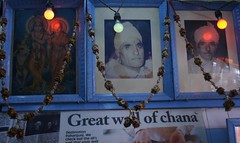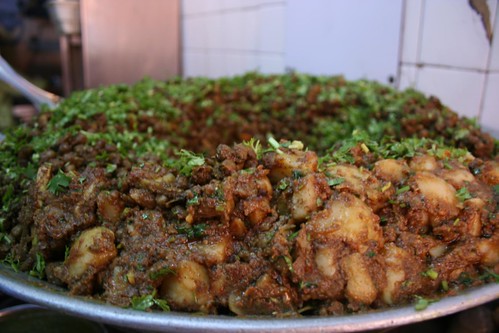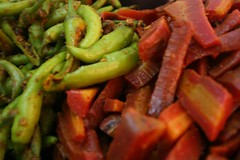The August 2009 issue of SpiceRoute, SpiceJet airline’s inflight magazine carries a two page, 938 word article titled “What’s in Your Khomcha?” by Hirak Gautam, on pages 42 & 43. Without further ado, I present to you the entire text of the article, along with excerpts from previous posts on this blog, and commentary. Scanned images of the original pages are available here and here. Enjoy 🙂
It has been 10 minutes on the treadmill and I am already regretting my last seven days of rampage. The whirlwind visit to Delhi’s Khomchawalas with my cousin, who is an aspiring chef, was a real eye opener.
One muggy afternoon we headed straight to the Walled City for what turned out to be a complete gastronomic delight. As I walked weaving through the crowd and dingy streets, it made me understand that Delhi is a potpourri of people, and many of them sell food for a living.
As we eagerly track our friend Hirak in his journey across Delhi’s gastronomic delights, we will follow the convention of quoting him in olive green, with excerpts from the EOiD blog figuring in a navy blue. Don’t ask me why.
Our first stop was the famous Kallu’s Nihari take-out in Jama Masjid, but the shop itself was drowned in a sea of customers. After a waiting period of exactly 10 minutes, what came into view was a small tiled area serving as a place to sit on the floor and eat. Its close proximity to the tandoor forced the people to spread themselves around the shop; be it the doorstep of a neighbouring house, the parapet of a broken wall, or the seats of a parked scooter. The heat and taste had driven both of us in a tizzy and we hardly remember the act of eating the nihari. But what I do remember is the sight of two shiny plates after having mopped spotless with soft, piping hot khameeri rotis. The usual helpings of nihari are for Rs 15, but you can order the larger size for Rs 25. Rotis are for Rs 2 each.
If you happen to do a Google search for “Kallu nihari”, it so happens that the EOiD blog post I wrote on September 2, 2007 comes up as the top hit. I would hazard this is how Hirak first chanced upon our little blog. Here are some relevant excerpts from that post:
… even before we could see the shop itself, a reassuring throng of customers came into view. I wouldn’t have thought it possible, but Kallu’s shop is even more modest than Haji Noora’s in Bara Hindu Rao, with just a small tiled area serving as a place to sit on the floor and eat. Its proximity to the tandoor means that in this weather, sitting inside the shop makes Dante’s Inferno sound like a nursery rhyme. Consequently, most people prefer to find a spot outside, be it the doorstep of a neighbouring house, the window ledge on an unsuspecting wall, or the seats of a parked scooter… Despite my induced gustatory amnesia of the whole event, I am certain the nihari must have been good, because in minutes both Vinayan and I had used the soft, piping hot khameeri rotis to mop up our extra-large plates of nihari to the point of sparkling… Price: The usual helpings of nihari are for Rs. 15, but you can order the larger size for Rs. 25. Rotis are Rs. 2 each.
Apart from the similarity of the text, it is sad that the readers of SpiceRoute will be misled by Hirak’s article on at least two counts: (a) they’d think Kallu’s nihari can be had on a “muggy afternoon”, whereas it’s never actually served before 5pm or so; (b) they would expect prices to be the same as what existed in 2007, when I originally wrote my post.
Be that as it may, let us follow Hirak as he discovers the EOiD post on Daulat ki Chaat, published online by me in October 2006.
Post our nihari tasting session, we moved towards a hidden gem of Delhi street food – Daulat ki chaat. As we both passed by an inconspicuous vendor swarmed with flies and the local cognoscenti, both hovering around a demure white platter perched on a three-legged contraption. I knew better than letting this one pass by. (And before you hygiene freaks turn up your snooty little noses, the platter was well covered with a muslin cloth, so only the cognoscenti and not the flies actually got a taste of the goods.)
The grand preparations begin at 2a.m every day and they insist that their only contribution is to churn some creamy milk and whip up its froth. This whipped froth of milk is set in a large brass pan, and some khoya and finely sliced pista are sprinkled on top. A big spoonful simply vanishes in the mouth, and has a very sophisticated, understated sweet taste to it. Any reasonable person would demand a princely sum for such an ethereal treat. Yet in the by-lanes of Shahjahanabad, a dona of Daulat ki Chaat makes you lighter exactly by 10 bucks.
Allow me to reproduce excerpts from the original EOiD post:
On our expedition for a breakfast of nihari yesterday, Abhik and I chanced upon one of the true hidden gems of Delhi’s street food — Daulat ki chaat.
I’d already been tipped off about this by a Rahul Verma column from some time back, so when Abhik and I passed by an inconspicuous vendor with flies and the local cognoscenti buzzing around a demure white platter perched on a three-legged contraption, I knew better than not to screech to a halt.
(and before you hygiene freaks turn up your snotty little noses, the platter was well covered with a muslin cloth, so only the cognoscenti and not the flies actually got a taste of the goods.)
…
They start making it at about 2 o’clock at night, and insist that their only contribution is to churn some creamy milk and whip up its froth — the rest is the magic of the winter dew. This whipped froth of milk is set in a large brass pan, and some khoya and finely sliced pista are sprinkled on top. … A spoonful of it just vanishes in the mouth, and has a very sophisticated, understated sweet taste to it.
Any reasonable person would demand a princely sum for such an ethereal treat. Yet in the by-lanes of Shahjahanabad, a dona of Daulat ki Chaat sets you back by exactly 10 bucks!
Again, not only does Hirak copy and paste directly from my blog post, he also significantly misleads his readers in two respects: (a) his chronology makes the reader imagine that it is possible to get Daulat ki Chaat in old Delhi after a nihari-eating session on a “muggy afternoon”, whereas in reality Daulat ki Chaat is available only in the winters, and generally only uptil about noon; (b) the price of Rs. 10 actually dates from 2006, and I am happy to know that the chaat vendors have managed to raise their prices in these last three years in step with overall inflation.
Hirak now goes to his “favourite chaatwaala”, Hira Lal, whom I just happened to have written about in this blog in February 2008:
While chaat was still on the menu, we didn’t want to ignore my favourite chaatwaala in Chawri Bazaar, who always managed to serve us something special.
At night, once the paper traders of Chawri Bazaar have downed their shutters and the throb of commerce has quietened to a murmur, Hira Lal Chaat Waala’s shop stands out with pride. For four generations, people have come here for their choice of snacks – alu chaat, fruit chaat, alu tikkis, and even pao bhaaji.
But hiding amongst the goodies is a charming nugget that is hard to find outside these parts: kulle, or kuliya, as they are fondly called, are made by scooping out one of several vegetables into cup shapes, which are then filled with chick peas, pomegranate seeds, various tangy spices and a dash of lemon.
Here are parts of the original EOiD blog post:
… That’s when he’d dragged us to his favourite chaatwaala in Chawri Bazaar to show us something quite special.
In the night, once the paper traders of Chawri Bazaar have downed their shutters and the throb of commerce has quietened to a murmur, Hira Lal Chaat Waale’s shop stands out like a beacon by a darkening sea. … For four generations, people have come here for their choice snack — alu chaat, fruit chaat, alu tikkis, and even pao bhaaji.
But hiding amongst the goodies is a charming nugget that is hard to find outside these parts: kulle, or kuliya, as they are often fondly called, are made by scooping out one of several vegetables into cup shapes, which are then filled with chick peas, pomegranate seeds, various tangy spices and a dash of lemon.
The next paragraph Harik can proudly claim as his original:
On our way back, we wondered at the wide diversity of cuisine, Delhi streets have to offer. The latest craze of the town, steamed momos, vegetarian and non-vegetarian (it can carry anything) and the accompanying hot red chutney, can beat even the Moroccan harisa. You can find it anywhere and everywhere, turning all ambitious Tibetans into entrepreneurs.
He isn’t quite done yet, because his “Bengali sweet tooth” has led him directly to the recent EOiD post on Kuremal’s Kulfis:
Though we manage to abstain from the street version of the original dim-sums, the Bengali sweet tooth led us to a place called Kuremal’s Kulfi.
And the novel discovery I made there happened purely by chance. ‘Stuffed Kulfi’’ – a variation that comes in the fruity flavours of orange and mango. The stuffed mango kulfi is made by taking out the mango stone and most of the flesh and fillling it with rabri, or plain kulfi mix. When frozen, the skin is peeled away and the ice sliced to give a fabulous combination of rabri and frozen mango flesh.
Pamela Timms, an EOiD member and avid foodie, writes a wonderful blog of her own. She originally wrote a piece on Kuremal’s for her blog in April this year, but since several of her foodie adventures are with the EOiD gang, she is kind enough to allow me to republish some articles on this blog. Here are the matching excerpts from her post, which we published on April 26, 2009:
I’ve recently discovered the ‘Stuffed Kulfi’ — the orange and mango are particularly delicious. The stuffed mango kulfi is made by taking out the mango stone and most of the flesh and filling it with rabri, or plain kulfi mix. When frozen, the skin is peeled away and the ice sliced to give a fabulous combination of rabri and frozen mango flesh.
Meanwhile, Hirak bravely soldiers on:
After exploring almost all the lanes and bylanes of the Walled City, we headed to relax in an al fresco lounge. Sitting and watching people dunk pieces of pita into hummus and babaghanoush had me immediately thinking of characteristically bland chickpeas, the main ingredient in hummus. And of the earthy flavour that our streets infuse in those very same grains of of gram, turning them into deliciously delightful Choley Bhaturey.
Indeed. What disturbs me most is that a few hours in front of the computer screen reading the EOiD blog can give Hirak the heady feeling of having “explored almost all the lanes and bylanes of the Walled City”, when after three years of tramping those parts, I am acutely aware of having seen only a fraction of that labyrinthian wonderland.
Nonetheless, his writing makes for tantalizing reading – an “al fresco lounge” with hummus and babaghanoush is mentioned, but never named. On my first read, I had credited this para to Hirak’s own creativity, until I carefully read another post by Pamela on our blog. Some of the introductory lines of her post on Sitaram Dewan Chand’s Chhole Bhature go like this:
… chick peas? Synonymous with hairy hippies in bedsits and tubs of slimy supermarket hummous? Then came Chana Bhatura and I discovered I could actively crave something involving chick peas.
Aha! There you go — Hummus! And to wit, no mention of a place to eat it!
Having set the stage Hirak now delves whole-heartedly into Chhole Bhaturey:
The next morning, still hung over from our previous day’s food cocktail, we decided to see the other parts of Delhi. We also decided to visit the most popular joints of all time like the Evergreen in Green Park and Nathu in Bengali Market with their maginificent balloon-sized puffed-up bhatura. In my early days the accompanying chana was just a sloppy, sludge-coloured distraction. I used to dip the bread but I’m ashamed to admit the chick peas often went back to the kitchen barely touched, however, not any more. Eateries like Sita Ram Dewan Chand in Paharganj offers ‘unlimited chana’ and can be termed as one of Delhi’s finest street food joints.
And here is what Pamela had written in that post on Sitaram Dewan Chand:
… I admit what first attracted me to this dish, in places like Evergreen in Green Park and Nathus in Bengali Market, were the magnificent balloon-sized puffed-up bhatura. In the early days the accompanying chana was just a sloppy, sludge-coloured distraction. I used to dip the bread but I’m ashamed to admit the chick peas often went back to the kitchen barely touched… I’m now more likely to eat at the kind of joint that offers ‘unlimited chana’. Like Sita Ram Dewan Chand in Paharganj, where Hemanshu and I headed last week in the latest leg of our mission to persuade Delhi’s finest street food joints to part with their secret family recipes.
Hirak now conscientiously writes his own conclusion to the article:
The journey went on to find those nooks and corner of our very own Dilli and now I am 40minutes up on the treadmill, already waiting for another such gastronomic journey soon.
Bravo! I must admit this blog has been languishing for I have been far too busy with other work. The image of Hirak, waiting impatiently for material for his next virtual “gastronomic journey”, is just what I needed to get back to writing. For that Hirak, and for being such a sincere flatterer, I thank you.





